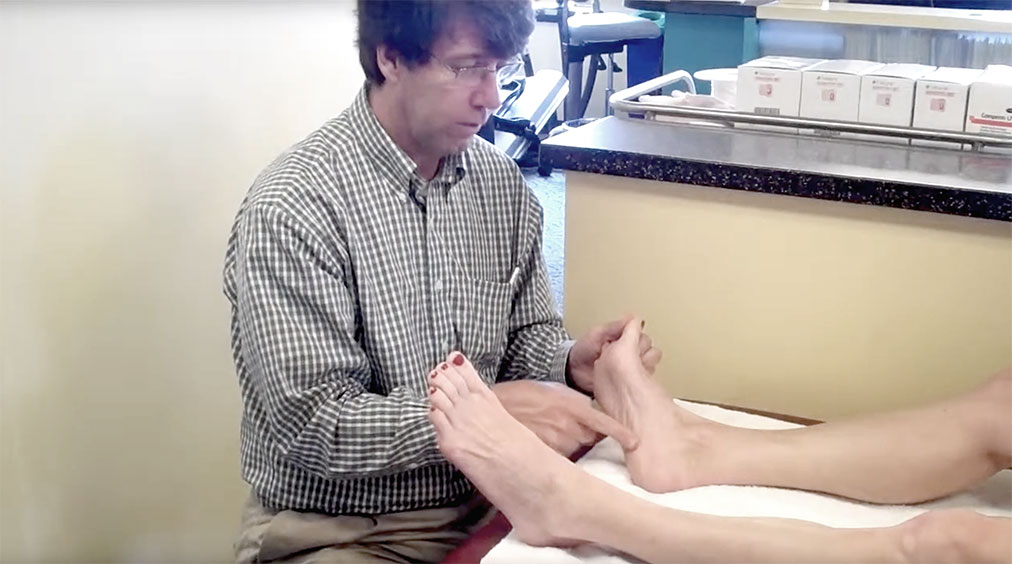Last week I started a discussion on a patient with acute plantar heel pain and chronic recurrent achilles tendonitis. I started the conversation as if it was a limited first visit and you had to come up with your working diagnoses to start treatment moving forward. I presented the 2 simple protocols beyond that can help with the management of the patient and suggested that you have protocols like this readily available for all your working diagnoses that commonly present to your office. Let me know if you have any need for my typical treatments for these diagnoses like plantar fasciitis, Morton’s neuromas, bunions, etc, and I will try to continue to post about these that interest you.

- Acute Plantar Fasciitis: Soft OTC arch support, plantar fascial and achilles stretching 3 times daily, activity modification to obtain 0-2 pain levels, no barefoot walking, and icing 3 times daily
- Chronic Achilles tendonitis: Stretching also 3 times daily both gastrocnemius and soleus, and nonpainful evening 2-sided straight and bent knee heel lifts, icing twice daily, changing to a shoe with an elevated heel if presently in zero-drop, and staying in 0-2 pain levels.
The above two working diagnoses were pretty much Occam’s Razor examples. Occam’s Razor says that the simplest explanation (in this case diagnosis) is usually the correct one. Of course we know that there are many examples of exceptions to this rule. If the goal of this second visit, where I always expect the patient to improve with each visit, is to assess the accuracy of your diagnosis or diagnoses, the 4 following Improvements can help you.
Improvement #1: Simply add a prescription 4-6 PT visits for their expertise at pain reduction, stretching safely, and gradual strengthening. There you are developing a rapport with a physical therapist, getting there read on diagnosis and treatment plan. I always want a note from the therapist about their thoughts, and I want the patient to email me how the treatment is starting. Of course, these communications can be through the EHR and require little but meaningful time.
Improvement #2: Examination of the heel and achilles to confirm or fine-tune your working diagnoses. As you practice, the more physical examinations you can perform, the better you will be. Knowing the location of the origin of the plantar fascia off the medial calcaneal tuberosity versus the plantar surface of the heel bone and its soft tissue vs pain produced from side to side compression of the heel, or where you can find the most sensitive spot for Baxter’s nerve.
Improvement #3: Watch them walk to check for signs of instability (medial or pronatory instability may require an orthotic evaluation visit). In many cases of heel pain, you have to transfer enough weight into the arch, soften the heel, and align the heel to offweight the first ray and allow the Windlass mechanism to work. You have three areas to work orthotic wise with. The heel valgus and placing some varus support, the medial arch, and the first metatarsal head. Freeing up the first metatarsal head so it can plantarflex is helped by met pads, dancer’s pads, scaphoid pads, and an assortment of varus wedging techniques. The disconnect for many is why we need to focus on the first met head with a patient with plantar heel pain. A dysfunctional overly stretched plantar fascia, that can not help plantarflex the first met, produces tension at the heel.
Improvement #4: Proper assessment of achilles flexibility and strength. Both achilles tightness and poor to fair tone, is an easy source of heel pain. A weak achilles can develop heel pain due to a prolonged stance phase or increased overall weight bearing step after step. A tight achilles can compensate with subtalar joint pronation and elimination of the Windlass, or an early heel off and increased dorsiflexion force on the first ray. Therefore, the continual evaluation of achilles flexibility helps achilles problems, along with plantar heel pain.
These 4 improvements are easily entered in the assessment of your visit to review when the patient comes in for their follow up visit. They are listed under possible interventions: PT, heel and achilles exam, gait, and full achilles assessment for tightness and weakness. Let me know your thoughts.






